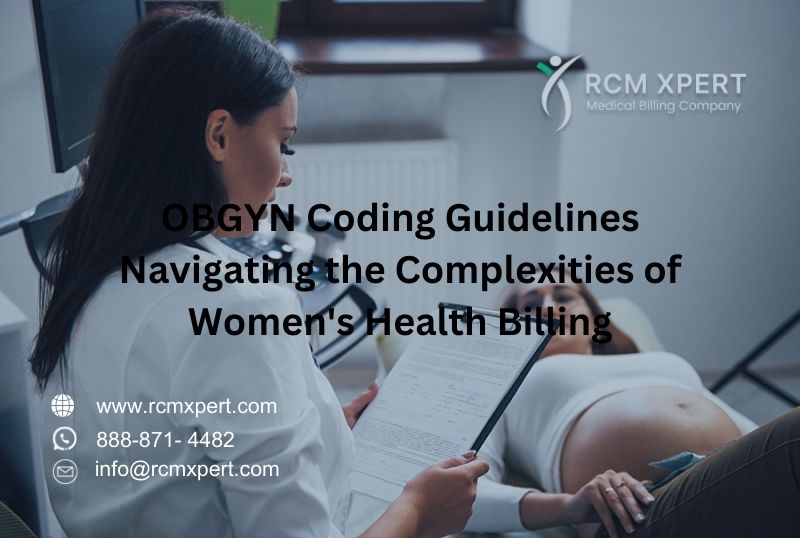In the intricate world of medical billing, obstetrics and gynecology (OB/GYN) coding stands out as a particularly complex field. With its unique procedures, time-based services, and bundled care packages, OB/GYN coding requires a deep understanding of both medical practices and billing intricacies. This comprehensive guide will walk you through the essential OB/GYN coding guidelines, helping you navigate the challenges and ensure accurate, compliant billing for women’s health services.
Why OB/GYN Coding Matters
Before we dive into the specifics, let’s talk about why mastering OB/GYN coding is so crucial:
- Ensuring proper reimbursement: Accurate coding means you’re getting paid fairly for the services provided.
- Maintaining compliance: Correct coding helps you stay on the right side of healthcare regulations.
- Improving patient care: Proper coding contributes to better medical records, which can lead to improved patient outcomes.
- Streamlining operations: When coding is done right, it reduces claim denials and administrative headaches.
Now that we understand the importance, let’s explore the key areas of OB/GYN coding.
Obstetric Care Coding: The Basics
Obstetric care is a cornerstone of OB/GYN practice, and it comes with its own set of coding challenges. Here’s what you need to know:
Global OB Packages
Most insurance payers use a global obstetric care package, which typically includes:
- Prenatal care (usually 13 visits for uncomplicated pregnancies)
- Intrapartum care (labor and delivery)
- Postpartum care (usually up to 6 weeks after delivery)
The global OB package is billed using a single CPT code, depending on the type of delivery:
- 59400: Vaginal delivery, including prenatal and postpartum care
- 59510: Cesarean delivery, including prenatal and postpartum care
- 59610: Vaginal birth after cesarean (VBAC), including prenatal and postpartum care
- 59618: Attempted VBAC resulting in cesarean delivery, including prenatal and postpartum care
Coding for Complications
When complications arise during pregnancy or delivery, additional codes may be necessary:
- Use appropriate E/M codes: For visits related to complications, use the appropriate evaluation and management (E/M) codes.
- Add modifier -25: Append modifier -25 to the E/M code to indicate a separately identifiable service.
- Include diagnosis codes: Be sure to include the relevant ICD-10 codes to specify the complication.
Multiple Gestation
For multiple pregnancies, use codes that specify the number of fetuses:
- 59400 (single) vs. 59510 (twins)
- Add codes 59409-59412 for each additional fetus beyond twins
Gynecological Procedures: Key Coding Considerations
Gynecological procedures form another significant part of OB/GYN practice. Here are some essential coding tips:
Diagnostic vs. Screening Services
It’s crucial to distinguish between diagnostic and screening services:
- Screening: Use code Z01.411 for encounters without abnormal findings.
- Diagnostic: Use specific codes for encounters prompted by signs or symptoms.
Coding for Pap Smears
Proper coding for Pap smears involves both the collection and the laboratory analysis:
- Q0091: Collection of screening Pap smear
- 88141-88175: Cytopathology codes for laboratory analysis
Remember to use the appropriate diagnosis code (Z12.72 for screening, or specific codes for diagnostic purposes).
Colposcopy and Biopsy
When coding for colposcopy and biopsy procedures:
- Use code 57452 for colposcopy of the cervix
- Add code 57455 if a biopsy is performed
- Include any relevant diagnosis codes
Ultrasound Coding in OB/GYN
Ultrasound is a vital tool in OB/GYN practice, and coding for these services requires attention to detail:
First Trimester Ultrasound
- 76801: First trimester ultrasound, single or first gestation
- 76802: Each additional gestation (use in conjunction with 76801)
Second and Third Trimester Ultrasound
- 76805: Second or third trimester ultrasound, single or first gestation
- 76810: Each additional gestation (use in conjunction with 76805)
Transvaginal Ultrasound
- 76817: Transvaginal ultrasound, obstetric
- 76830: Transvaginal ultrasound, non-obstetric
Remember to include the appropriate diagnosis codes to justify the medical necessity of the ultrasound.
ICD-10 Coding in OB/GYN: Essential Tips
Accurate diagnosis coding is crucial in OB/GYN practice. Here are some key points to remember:
Pregnancy Status
Always include a code from category Z33 to indicate pregnancy status when relevant.
Trimester Coding
Many obstetric codes in ICD-10 require specification of the trimester:
- First trimester: less than 14 weeks 0 days
- Second trimester: 14 weeks 0 days to less than 28 weeks 0 days
- Third trimester: 28 weeks 0 days until delivery
Sequencing of Codes
In obstetric cases, the principal diagnosis should be a code from Chapter 15 of ICD-10 (Pregnancy, Childbirth and the Puerperium), unless the visit is unrelated to the pregnancy.
Common OB/GYN Coding Pitfalls to Avoid
Even experienced coders can stumble in the complex world of OB/GYN coding. Here are some common pitfalls to watch out for:
- Unbundling global OB care: Avoid billing separately for services included in the global package.
- Incorrect use of modifiers: Make sure you’re using modifiers like -25 and -59 correctly and only when necessary.
- Overlooking NCCI edits: Be aware of National Correct Coding Initiative (NCCI) edits that may affect your coding.
- Improper use of time-based codes: When using time-based codes, ensure you’re documenting time spent accurately.
- Forgetting to code for separately billable services: Some services, like non-stress tests, are not included in the global OB package and should be billed separately.
Staying Up-to-Date with OB/GYN Coding Changes
The world of medical coding is constantly evolving, and OB/GYN coding is no exception. Here are some strategies to stay current:
- Regular training: Attend coding workshops and webinars specifically focused on OB/GYN coding.
- Subscribe to coding publications: Stay informed about changes through publications from organizations like ACOG and AAPC.
- Utilize online resources: Take advantage of online coding tools and forums for real-time updates and peer discussions.
- Conduct internal audits: Regular audits can help identify areas for improvement in your coding practices.
Conclusion: Mastering OB/GYN Coding for Better Practice Management
Navigating the intricacies of OB/GYN coding can be challenging, but it’s essential for maintaining a healthy medical practice. By understanding the nuances of global OB packages, properly coding for gynecological procedures, mastering ultrasound coding, and staying vigilant about common pitfalls, you can ensure accurate billing and optimal reimbursement.
Remember, good coding practices not only benefit your bottom line but also contribute to better patient care through improved record-keeping and more efficient healthcare delivery. As you continue to refine your OB/GYN coding skills, you’ll be better equipped to handle the unique challenges of women’s health billing, ultimately leading to a more successful and compliant practice.
Stay curious, keep learning, and don’t hesitate to seek expert advice when faced with complex coding scenarios. With dedication and attention to detail, you can master the art and science of OB/GYN coding.














